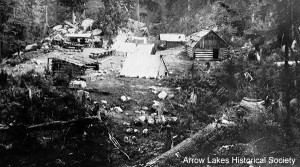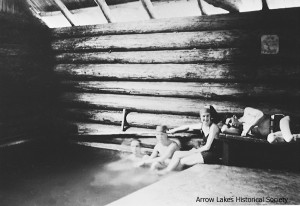Written by Rosemarie Parent, using information from the Arrow Lakes Historical Society’s publications and extensive archives.

Although the town of Nakusp started in 1892, the Nakusp Hot Springs, nine miles up the Kuskanax valley, were not staked until about 1894 by Messrs. Darragh and Lester. Even then, this wilderness thermal wonder was regarded as a God-given gift that should be open to the public, free and unobstructed. The government cancelled the application, returning the men’s down payment, after the objections by the public.
D. Alan and Ellen McDougald, from California were relative newcomers to British Columbia, where they were lured by the prospecting opportunities in the Kootenays. They purchased the Leland Hotel from Mr. Rathwell for $1,000 in 1892, and were involved in all social work to obtain necessities for the town, such as a school. Alan died as the result of tuberculosis in 1895, leaving his wife, Ellen, and three children to run the hotel and make a living.

Ellen liked to be involved in various local developments and made an application for 320 acres of land in Burton along the Columbia River. She then used a different tactic in obtaining the Hot Springs site in 1897. She staked the lot, 8514, like a prospector would, under the name of the Virginia Mineral Claim. No development was undertaken for some time, which left the public to continue to use it at will.
Easier access was provided in 1912 by the building of a proper trail from town. Two years later, public protest paid off with the government putting the site into a reserve by order in Council. Mrs. Gayford (Ellen had remarried) again fought the issue and gained surface rights to her mineral claim. Buoyed by her victory, Ellen started a camp and attempted to charge for the water’s use. But this required some administration, an expense that rendered the operation unprofitable.
In 1925, when the Nakusp Board of Trade took action against Gayford, a government survey was instituted to form a Class C park and a road, routed through the middle of the spring’s site. It was further recommended that for all time and ever, two of the three springs be reserved for the people, and that a public park be gazetted consisting of about 200 acres surrounding the springs. The McDougald claim was relinquished in 1928 and through tax sale, was purchased by the Sid Leary family in 1939.
Bert Herridge was installed as chairman and Frank Rushton as secretary-treasurer to the Nakusp Hot Springs Board in 1928. Their job was to solicit funds throughout the area to improve the facility and if they were successful in raising $500, this would be matched by a government grant secured by MLA Sid Leary. This money allowed the Board to proceed with construction of a concrete pool and enclosure. Karl and Emil Newbrand got the contract to build the pool with a house over top. A community kitchen and some cabins were also built about this time. All materials and equipment had to be packed in by horse or on one’s back. However, Karl and Emil used the sand from the creek for the concrete and made the forms from cedar shakes.
A caretaker was hired for $300 for the summer and many young people provided a horse packing service to the increasing volume of visitors now coming from outside points. There was a $5 season levy for packers who used the corral and 25 cents for casual users. The trail was in good shape and mile boards were erected. The caretaker was Amos La Rue in 1929 and he enforced rules that were set out by the Provincial Parks Act. Permits for campfires were required and safety and cleanliness regulations were followed.
In 1935, Louis (Pop) Gensick had taken over the job of caretaker from Amos and though there was no money for development, he worked hard to keep the little spa clean and hospitable. In 1939, Pop took the Gensick mill, piece by piece, to the Hot Springs. He commenced to cut lumber for a series of small cabins and later, an open building circular in design. Pop stayed over in isolation a few winters to spend the time needed to complete this project. About this time, the price for using the springs was one dollar per season per family and 25 cents per day for a cabin.
A tragic accident in the spring of 1940 occurred when Pop severely cut his hand and wrist on the saw of his portable mill. John Houston, who stayed with Pop during the winters, managed to get a tourniquet in place to stop the bleeding. He then decided to walk to town for help, even though he was very crippled with arthritis and could barely walk. He set out in the dark with a flashlight and battled the snow covered trail, crawling and slithering until he arrived at Pop’s son Paul’s cabin at 12:30 that night. Paul, Emil Newbrand, Roy Rogers, Robert La Rue, Constable Jackson and other volunteers hiked to the springs to help bring Pop to town on a stretcher. They arrived at 11:30 in the morning and his hand was saved although reduced in mobility. John Houston had saved his friend’s life and for this he received a certificate from the Royal Humane Society.

Emil Juras managed the springs in 1942 and Albert Beck spent hundreds of volunteer hours to maintain the trail at this time. Pam Gillman was one of the packers with the name ‘Pam’s Pony Express’ who can tell you many exciting and hilarious stories of her experiences.
In 1957, the Leary family donated ten acres of land on and around the hot springs to the town. There was a stipulation that the Nakusp Hot Springs Provincial Park Board composed of Graham Elder, Bert Gardner, Heather Gates, Al Butt, Dave Johnson and Bert Herridge, complete a survey at a cost of $375. The money was borrowed from the bank, for which the public made donations to offset the expense. At this point, the government insisted the title would have to be registered under the Crown. Florence Leary wanted it registered to the town itself and requested the ten acres be classified as a Class A Park. She was told it was too small to do this, it would require forty-five acres.
Ten years went by and Nakusp became a village in 1967, and was offered a chance for ownership of the springs. This did not pan out as they had hoped. There was only a logging road pushed into the area at this time, which was poorly maintained, but in spite of this, hundreds of visitors still came to the springs. There were no caretakers; the cabins and pools were damaged by vandals because there was no one there to keep order.
A committee was formed in Nakusp to investigate the possibility of piping the hot water to a better camping site and produce a plan for a proper pool complex. The Mayor of Nakusp was asked to have the town accept administration, through a board, of such a complex while all levels of government were approached to get financing for the erection of the spa.

A good logging road had now been pushed through to near the springs, so when grant money from the various governments came forth, access was made possible without too much additional cost. Finally in 1974, the complex was completed and opened by Premier, Dave Barrett. It had taken eighty years of struggle to obtain the ownership of the springs but now Nakusp had a first class spa that people could enjoy and proudly offer to the world.
There is some confusion as to whether the area was designated as a Class A Park as stated in the AL News in 1967. There is documentation in 1992 that means (we think) that the park reverts to Crown once again. It makes sense that if this lot is the one with the hot springs source, being mineral water, it could never be owned by anyone but the Government. We need to do some more research on this.
In 2003, the town of Nakusp purchased the 77.2-acre parcel of land upon which the Hot Springs is situated. The Village had been leasing the Hot Springs from the province for about $11,000 per year of $950 per month. We had to borrow the money – $88,000 plus GST – over a 12-year term but the Village saves on interest costs resulting in a monthly payment of only $250. The advantage of owning rather than leasing is that now we can encourage developers to build. They were not interested on building on leased land.
In this current crisis with the need to upgrade and meet new standards and Government regulations, the public is asked to participate and come to meetings to discuss ways and means to preserve this valuable asset to the town. So many people worked so hard without pay in most cases to make sure that Nakusp kept this Hot Springs for the town. Let us make sure that this continues.
